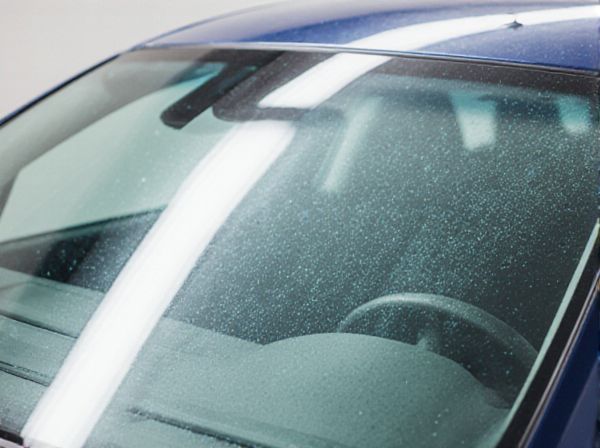
Photo illustration: Hydrophobic Coated Windshield vs Non-Coated Windshield
Hydrophobic coated windshields repel water more effectively, improving visibility during rain and reducing the need for frequent wiper use. Non-coated windshields tend to accumulate water and dirt, which can obstruct your view and require more maintenance. Choosing a hydrophobic coating enhances safety and driving comfort in wet conditions.
Table of Comparison
| Feature | Hydrophobic Coated Windshield | Non-Coated Windshield |
|---|---|---|
| Water Repellency | High - water beads and rolls off quickly | Low - water clings, reduces visibility |
| Visibility in Rain | Improved - clearer vision during rainfall | Reduced - water buildup hinders view |
| Maintenance | Easy - repels dirt and grime | Frequent cleaning needed |
| Durability | Lasts 6-12 months per application | No added durability |
| Cost | Higher initial price for coating | Lower cost, no coating required |
| Windshield Wiper Efficiency | Improved - wipers glide smoothly | Standard - wipers may streak |
Introduction to Hydrophobic Coated vs Non-Coated Windshields
Hydrophobic coated windshields feature a specialized water-repellent layer that enhances visibility by causing rainwater to bead and roll off quickly, reducing the reliance on windshield wipers. Non-coated windshields lack this treatment, often resulting in water accumulation that can impair driver vision during adverse weather conditions. The durability and maintenance benefits of hydrophobic coatings contribute to improved safety and driving comfort compared to traditional glass surfaces.
What Is a Hydrophobic Coating?
A hydrophobic coating is a specialized chemical layer applied to windshields that repels water, causing rain to bead up and roll off quickly for improved visibility. This coating enhances driving safety by reducing the need for windshield wipers during light rain and preventing water spots and dirt buildup. Compared to non-coated windshields, hydrophobic coatings provide superior water resistance and easier maintenance, significantly enhancing clarity in wet weather conditions.
How Non-Coated Windshields Perform in Weather
Non-coated windshields often accumulate water, dirt, and grime more quickly during rain or snow, obscuring visibility and requiring frequent use of wipers. Their glass surfaces lack the water-repellent properties that cause water to bead and roll off, leading to streaks and reduced clarity. In foggy or humid conditions, non-coated windshields tend to fog up faster, impairing driver safety without specialized anti-fog treatments.
Water Repellency: Hydrophobic vs Non-Coated Comparison
Hydrophobic coated windshields feature a nano-scale water-repellent layer that causes rainwater to bead up and roll off rapidly, significantly improving visibility and reducing the need for windshield wipers during light rain. In contrast, non-coated windshields lack this treatment, causing water to spread evenly across the glass surface, leading to decreased visibility and increased reliance on wipers. Studies show hydrophobic coatings can reduce the water adhesion by up to 90%, enhancing driving safety in wet conditions.
Visibility and Safety Differences
Hydrophobic coated windshields significantly enhance visibility by repelling water, causing rain to bead and roll off quickly, which reduces glare and improves driver reaction time. Non-coated windshields allow water to spread evenly, creating a film that distorts vision and increases the risk of accidents in wet conditions. The safety benefits of hydrophobic coatings are evident in decreased eye strain and clearer sightlines during adverse weather, contributing to overall road safety.
Maintenance and Cleaning Requirements
Hydrophobic coated windshields repel water and reduce dirt buildup, significantly lowering the frequency and effort required for cleaning compared to non-coated windshields. These coatings enhance visibility by preventing water spots and smudges, allowing for easier removal of debris with simple wiping or occasional rinsing. Non-coated windshields accumulate grime and water stains more easily, demanding more frequent and intensive cleaning to maintain clear visibility and windshield longevity.
Durability and Lifespan
Hydrophobic coated windshields offer enhanced durability by resisting water, dirt, and grime buildup, reducing the likelihood of scratches and wear compared to non-coated windshields. These coatings typically extend the lifespan of the windshield by maintaining clearer visibility and minimizing damage from environmental factors such as UV rays and acid rain. In contrast, non-coated windshields are more prone to surface degradation and require more frequent cleaning and maintenance, potentially shortening their effective lifespan.
Installation Process and Costs
Hydrophobic coated windshields require a precise application process involving a special repellent layer, often applied by professionals to ensure durability and effectiveness, which increases installation time and labor costs compared to non-coated windshields. Non-coated windshields have a straightforward installation similar to standard glass replacement, typically costing less due to the absence of specialized materials and treatments. The higher upfront expense of hydrophobic coatings is offset by long-term benefits such as improved water repellency and reduced need for windshield wiper maintenance.
Environmental Impact Considerations
Hydrophobic coated windshields reduce water accumulation, enhancing driver visibility and safety during wet weather, which can lead to fewer accidents and lower environmental damage from collisions. The production of hydrophobic coatings involves chemicals that may have environmental impacts if not managed properly, whereas non-coated windshields typically lack these additives. Over the vehicle's lifecycle, the improved efficiency and reduced need for windshield wipers on hydrophobic coatings contribute to lower water and energy use, supporting environmental sustainability.
Which Windshield Is Right for You?
A hydrophobic coated windshield repels water, reducing glare and improving visibility during rainy conditions, making it ideal for drivers who prioritize safety and clear vision in adverse weather. Non-coated windshields lack this water-repellent technology and may require frequent use of wipers, which can lead to streaks and reduced visibility. Choosing the right windshield depends on your driving environment, with hydrophobic coatings offering enhanced performance in wet climates, while non-coated options may suffice in drier regions.
 caratoz.com
caratoz.com